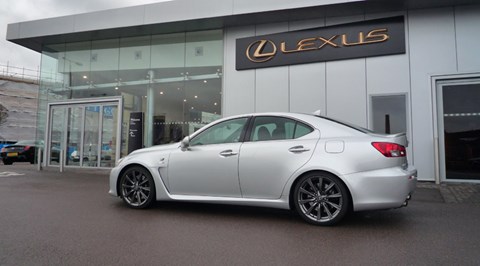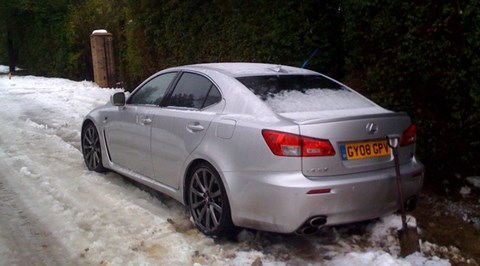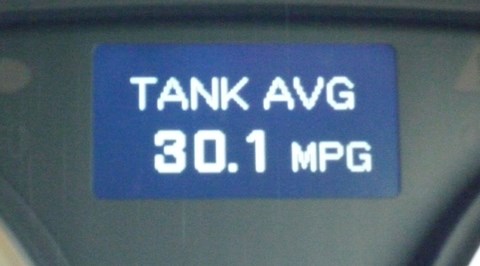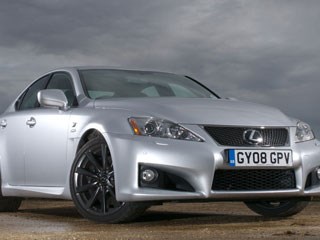I’m afraid I’ve been a bit lax with the Lex, or at least in telling you about it. The IS-F actually disappeared from the CAR car park in the autumn, since when I’ve been taking things at a somewhat more leisurely pace.
After 12 months and 22,000 miles at the wheel of a 170mph Lexus IS, I needed to calm down a bit. The F was seriously quick, particularly past 4500rpm when the two-stage intake system did its work and piped a load more power to the wheels and a brilliantly bassy growl into the cabin.
It was a great year, and not just because of the ability to hit 62mph in 4.8sec. There were surprises: regularly averaging an indicated 30mpg from a tank on longer journeys (on a V8 M3 rival!), making the back tyres last over 20,000 miles and finding that something went wrong (the keyless entry) even if it did fix itself by the next day.
I loved the IS-F’s dual personality, the fact that you could cruise around and let the eight-speed auto box do the work when you wanted to relax and that the seats offered comfort and support in equal measure.
But the ride from the non-adjustable dampers was dire, it annoyed me that you had to park up before disabling the stability system, the short 10,000 miles service intervals ramped up the cost and I really missed the practicality of my old Audi A6 Allroad. Obviously it would be unreasonable to expect a small sports saloon to be as useful as a wagon from the class above. But even among its peers, the Lexus struggles, offering far less luggage space, a smaller cabin and back seats that don’t fold down to allow longer loads.
So on more than one occasion I had to undertake a 140-mile round trip in our battered ’99 Focus when I needed to lug some big items. Don’t get me wrong, I like the old Ford, but it was a bit galling having to leave a £50k car on the drive. Watching a Clio breeze up my street last winter while the rear-wheel drive Lexus floundered in the snow was no fun, either.
It wasn’t snow that was to blame for the scrape on the front bumper (it wasn’t me, either!) but www.taketheweekendoff.com came to the rescue, filling and painting the damage at CAR’s office for a fraction of the price a bodyshop would have charged. Apart from that mishap, I didn’t incur any unexpected costs, although the front tyres would have lasted longer if they’d worn more evenly. Never did get to the bottom of that one.
I really enjoyed the Lexus but if I had £50k to spend on a sports saloon I’d probably spend it on a BMW M3, providing I could live with its massively inferior fuel consumption. Predictable, I know, but the bigger boot, folding back seats and softer ride would have as much to do with my purchase as its more interesting engine or more flamboyant cornering style, although a new limited slip diff option should even things on that count.
But don’t dismiss the Lexus out of hand. If you’re in the market for an M3 or C63, give the IS-F a try. It’s an interestingly different take on the sports saloon concept and the most characterful Lexus yet.
I’m in deep shock. I was pretty sure that the IS-F would finish its year with us with a clean copybook, but something has actually gone wrong with the Lexus. The use of the past tense in that last sentence is important: something did go wrong and then it fixed itself before I needed to call Lexus.
The keyless entry system packed up one evening and I was unable to lock the car either using the black button on the outer door handle or the remote button on the key fob. The solution was to slide the emergency old-fashioned key out of the remote, prise off the cover next to the handle covering the lock and do it the old fashioned way.
The next day I did the same to unlock the door. But the problem was also affecting the starting procedure. Normally you simply stamp your foot on the brake and press the start switch to the left of the steering column. I tried it but nothing happened and there is no ignition slot to insert the emergency key. But a message in the LCD display between the instruments told me to hold the key fob against the switch and then attempt to start it. The IS-F fired up as normal.
The same thing happened that evening when I came home, but weirdly, everything was working as normal in the morning. Maybe Lexus is so sensitive to quality issues that it sent elves out to fix in the night. Or maybe it was just a freak incident.
Whatever it was, I’ll mention it when the car goes in for its second service next week. I had been happy with the service at Lexus Leicester when the IS-F was due its 10,000 mile inspection apart from the fact that I had to spend an hour driving over there. Apparently they wouldn’t pick the car up for such a small job. So I was pretty narked to discover that had I contracted Lexus Cambridge to carry out that first service, they would have come to my house, whisked it away and brought it back when finished. Needless to say Cambridge got the 20k mile gig.
By Chris Chilton
 How often does your car need servicing? My last long termer, an Audi Allroad, didn’t need its first service until 19,000 miles thanks to Audi’s variable servicing schedule. The more gently you use the car – and the Allroad had done a lot of long trips – the longer the car can run before needing attention.
How often does your car need servicing? My last long termer, an Audi Allroad, didn’t need its first service until 19,000 miles thanks to Audi’s variable servicing schedule. The more gently you use the car – and the Allroad had done a lot of long trips – the longer the car can run before needing attention.
BMW’s M3 uses a similar system and can last up to 20,000 miles before needing any work done, although it does need an old fashioned running-in service at 1200 miles. The Lexus doesn’t need a running-in service but it does need one at 10,000 miles.
That’s so unusual these days that I managed to convince myself that the IS-F didn’t need attention until at least 12,000 miles. Fortunately my nearest dealer didn’t seem to think that our car breezing past its first service point by 2500 miles point was a problem, particularly as it’s barely six months old. I was more pleased about that than I was to find that my nearest city, Peterborough (pop close to 200,000), seems to be host to every other brand of car except Lexus. Lexus Leicester said they would pick it up next time for the longer, more involved 20,000 mile service, but this time I was going to have to make the hour long trek from home myself.
It took an hour to get there but when I arrived at Lexus Leicester I was greeted by a smart showroom, courteous staff and a decent cup of tea. I was even offered my own room to allow me to work while I waited, a nice touch.
The service itself highlighted no real problems other than the front tyres, which have worn heavily on their inner edges suggesting an alignment problem. The bill was £273, which sounds a lot considering what is actually involved in a first service today, but nearly £140 of that was accounted for by oil. Several days later a letter arrived at home from the garage just checking to see that I had been happy with the service. With attention to detail like it’s no wonder Lexus constantly romps away in the JD Power competitions.
By Chris Chilton
Back to top
IS-F in the snow – 10 February 2009
 Here are two pearls of wisdom I remember my Dad imparting during snowy weather when I was a kid: don’t forget to keep a spade in the boot and don’t be in a rear-wheel drive car. Living on a hill even steeper than the one on which my current house is located, it was advice you ignored at your peril.
Here are two pearls of wisdom I remember my Dad imparting during snowy weather when I was a kid: don’t forget to keep a spade in the boot and don’t be in a rear-wheel drive car. Living on a hill even steeper than the one on which my current house is located, it was advice you ignored at your peril.
Fast forward 25 years and, having ignored both pieces of advice, I managed to get the IS-F beached in a snowy verge having sailed down my street and past my driveway in the ice, ABS pumping wildly beneath my foot. It’s at times like this when ABS is more a hindrance than a help.
And it was amazing just how little of the white snuff was needed to render the IS-F completely immobile. There’s a snow button that dampens the throttle response but, being an automatic, you still don’t have as much control as you would in a manual car. And the electronically-braked rear diff was no use either. Most galling of all, a five year-old Clio drove straight past me up the hill without a hiccup. It was too dark to do anything last night so I had to leave it and hope that no one crashed into it overnight. And I spent 30 minutes this morning digging myself out in order to get to work. The snow is fading but the shovel is staying in the boot just in case.
It’s not just the Lexus that’s been suffering in this weather though. Every car I’ve seen in trouble in the last few days has been rear-wheel drive car, mostly BMWs, and most struggling with snow that wouldn’t give a Focus driver any concern at all. Suddenly Audi’s all-wheel drive RS philosophy is looking rather appealing.
By Chris Chilton
Back to top

It’s rare to find a car that achieves close to its official combined fuel consumption figure, a number achieved using a rolling road that doesn’t simulate gradients or the common man’s love of the right pedal.
But the IS-F is still averaging 24mpg, just 1mpg shy of the book value. Some of that credit must go to the type of use it gets. Although it spends a good portion of its time being flogged on the great B-roads around my house, my commute involves no urban driving, just a ten-minute trip down a free-running A1 and the frequent long motorway trips it takes make the best of the huge 40mph/1000rpm top gear. On the last of these I topped an average 30mpg again over two hours, at least according to the trip computer. By the time I’d filled up and checked the true figures a serious portion of town driving had knocked it back to a less incredible but still impressive 28mpg.
You don’t buy cars like this if you’re worried about economy though. Just as well because former CAR editor (and now publishing MD Rob Munro-Hall) has extracted just 16.5mpg from his M3 over the course of 10,000 miles. And while the IS-F looks likely to reach 15,000 on its original back tyres, Rob’s M3 will be heading for its third set despite the traction control remaining firmly on.
By Chris Chilton
 If the topic ever turns to small sports saloons on TV’s Family Fortunes, you can bet that an answer of BMW’s M3 would elicit that pleasing ding noise. For many it’s the default choice. But good as it is, there is a world beyond the M3, or so I keep telling my M3-obsessed colleague Ben Barry. Production of Audi’s brilliant last generation RS4 has ended and the new one is still a year away, but the thundering Mercedes C63 is vying for your cash and so is the Lexus IS-F.
If the topic ever turns to small sports saloons on TV’s Family Fortunes, you can bet that an answer of BMW’s M3 would elicit that pleasing ding noise. For many it’s the default choice. But good as it is, there is a world beyond the M3, or so I keep telling my M3-obsessed colleague Ben Barry. Production of Audi’s brilliant last generation RS4 has ended and the new one is still a year away, but the thundering Mercedes C63 is vying for your cash and so is the Lexus IS-F.
If you’ve seen a copy of CAR lately you’ll know that we’ve been running a Lexus IS-F on our long term fleet for the past few months. You’ll also know that it’s been piling on the miles at an astonishing rate thanks to its long legged cruising ability and huge refinement. And maybe the fact that it’s 416bhp V8 bellows like an Italian tenor past 4000rpm and rockets you to 62mph in under 5sec helped too. Whatever the reason, it arrived at CAR in late July with 1500 miles on the clock but just five months later has already topped 10,000.
Like its German rivals the Lexus has a front-mounted V8 and rear-wheel drive, its 5-litre unit offering an extra litre of swept volume over the M3’s eight but giving away 1200cc to the C63. And while it matches the BMW’s 416bhp and its 372lb ft is 77lb ft more than the Bavarian can muster, the Mercedes trumps them both with 457bhp and 442lb ft.
The Benz is also slightly quicker to 62mph, recording 4.5sec to the M3’s 4.7sec and the IS-F’s 4.8sec although the Lexus is the only one without an artificial speed limiter and will eventually sail past them and on to 168mph.
The truth is that there’s not an enormous difference in the feel from the drivers seat. They’re all hugely quick and capable of giving anything this side of a full-blown supercar real trouble. But where the Lexus and Mercedes come only with automatic gearboxes, the M3 can be had with either a traditional six-speed manual or BMW’s £2590 DCT dual clutch ‘box.
Specifying the DCT box shifts the normally £48,845 BMW from the cheapest car to the most expensive. The Lexus costs £50,076, around £270 less than the Merc but then the IS-F is loaded with crucial kit like sat-nav as standard (nav costs £750 on the Mercedes). The Lexus is also significantly greener than its rivals, even if its 25mpg combined figure and 270g/km CO2 output are hardly going to save the world.
That’s how the Lexus stacks up against its rivals on paper, but what about the spec of our car? Metallic paint, like most features, is standard on the IS-F and our car came in silver with contrasting black leather for the four seats – a useless pseudo centre console divides the rear seats. Those front chairs – strong on side support but not so grippy that you can’t move about freely – are electrically powered and heated too. In fact there’s only one option available, an electric sunroof at £785, and our car doesn’t have it.
The Bluetooth phone connection is useful and I love the graphics on the easy to operate touch screen infotainment system. The Mark Levinson hi-fi produces some wonderfully rich sounds too but it’s disappointing after my old Audi Allroad (which transposed your MP3 player’s screen onto the car’s and allowed you to control it through the MMI wheel) to find just a basic jack plug socket to plug my iPod into.
It’s not an especially roomy cabin – an M3’s is tangibly bigger – but it’s a great place to sink into ahead of a long drive: great driving position, smart carbon trim and top drawer build quality that adds to the sense of refinement. In fact there’s so little engine noise at urban speeds that it almost feels like a hybrid. Near 4000rpm though and a second inlet tract opens, the cabin fills with a hard V8 noise and the scenery really starts moving. The IS-F’s 372lb ft peaks at 5200rpm so you need to use the revs if you want to access the really titanic accelerative thrust possible.
That I don’t mind but personally I’d prefer a bit more vocal commotion low down, perhaps with the sport mode in play which currently tweaks the throttle response, steering and stability control. And I hate that you have to be at a complete stop before you can fully switch out the stability system. Not being able to means the rear tyres have lasted a lot longer than they would have otherwise though. The ride is too stiff for some in the CAR office but I’ve grown used to it and am really enjoying the IS-F’s body control, front-end grip and numb but accurate steering.
And as a confirmed fan of automatics I’m loving the auto ‘box. Eight gears is probably two too many but it’s smoother than the BMW’s DCT box in town and because the torque converter locks up on all gears bar first, the throttle response isn’t soggy like it can be with an auto attached to the engine. It also helps explain why the Lexus is averaging a bearable 24mpg and how I managed to record 30mpg on one gentle motorway run.
So despite a few very minor criticisms I’m a huge fan of the IS-F. I love the way it looks and judging by the faces of the surprising number of people who’ve spotted what it is, so does everyone else. One chap even came and knocked on the window when my girlfriend was out driving because he was so keen to tell her how great he thought the Lexus looked. Perhaps that it’s not just another M3 is part of the appeal for him as much as it is for me. After a slow start I’ll be adding regular updates to let you know how we get on over the next eight months so keep watching.
By Chris Chilton
Back to top